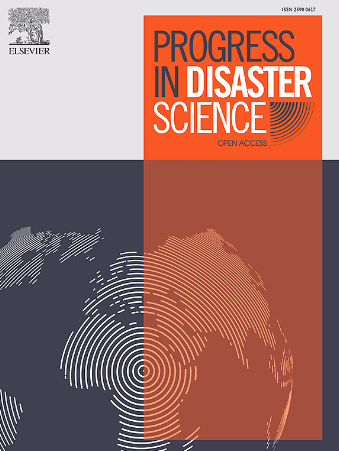利用机器学习和基于gis的方法对孟加拉国闪电引发的脆弱性进行评估
IF 2.6
Q3 ENVIRONMENTAL SCIENCES
引用次数: 0
摘要
本研究利用地理信息系统(GIS)和机器学习(ML)技术调查了孟加拉国闪电引起的脆弱性,解决了该领域有限的研究。闪电,特别是在4月至6月期间普遍存在,是孟加拉国的重大威胁,造成人员伤亡和经济损失。通过分析闪电和伤亡的时空模式,并将气象、地理和社会经济因素纳入ML模型(随机森林、多项逻辑回归、支持向量机和人工神经网络),本研究提供了对闪电影响的细致理解。研究结果表明,雷击事件呈下降趋势,但死亡人数不一定下降,这揭示了造成雷击事件的因素的复杂性。孟加拉国北部遭遇雷击较多,而东北部的伤亡率较高。相关分析表明,雷击死亡受多因素影响,与耕地面积(0.69)、农业人口(0.61)和闪电(0.45)的相关性较高。随机森林模型似乎是预测闪电易损性因素影响的最佳模型[高精度]。在孟加拉国,最重要的雷击脆弱性预测指标是耕地面积(32%),其次是识字率(19%)、农村人口(18%)、闪电(16%)和水域面积(15%)。农田和农村人口的广泛存在增加了农业高峰季节遭受雷击的风险,而识字率低又限制了人们对安全措施的认识,从而加剧了风险。此外,大型水体影响当地的小气候,并对在这些湿地及其周围工作或旅行的人(如农业劳动者和渔民)构成风险。气候变率导致闪电频率的变化,再加上社会经济差异和基础设施不足,进一步加剧了脆弱性。本研究开发的区级脆弱性地图为基于地理/区域的针对性政策干预提供了可操作的见解,以解决导致脆弱性的这些相互关联的因素。这种全面的、数据驱动的方法标志着我们对雷电脆弱性的理解取得了重大进展,并为制定应对孟加拉国雷电死亡的战略提供了宝贵的见解。本文章由计算机程序翻译,如有差异,请以英文原文为准。
Lightning-induced vulnerability assessment in Bangladesh using machine learning and GIS-based approach
This study investigates the lightning-induced vulnerability in Bangladesh using Geographic Information Systems (GIS) and Machine Learning (ML) techniques, addressing the limited research in this area. Lightning, especially prevalent during April to June, is a significant threat in Bangladesh, causing fatalities, injuries, and economic losses. By analyzing spatiotemporal patterns of lightning and casualties, and incorporating meteorological, geographical, and socio-economic factors into ML models (Random Forest, Multinomial Logistic Regression, Support Vector Machine, and Artificial Neural Networks), this research provides a nuanced understanding of lightning impacts. Findings indicate a downward trend in lightning strikes but not necessarily in fatalities, revealing the complexity of contributing factors. Northern Bangladesh experiences more lightning strikes, whereas the northeast has higher casualty rates. Correlation analysis indicates that lightning fatalities are influenced by multiple factors, with high correlations to cropland area (0.69), agricultural population (0.61), and lightning flashes (0.45). The Random Forest model has appeared to be the best model to predict [with high accuracy] the influence of lightning vulnerability factors. The most significant predictors of lightning vulnerability are cropland area (32 %) followed by literacy rate (19 %), rural population (18 %), lightning flashes (16 %), and water area (15 %) in Bangladesh. The extensive presence of croplands and rural populations increases exposure to lightning during peak farming seasons, while low literacy rates exacerbate risks by limiting awareness of safety measures. Additionally, large water bodies influence local microclimates and pose risks to those working or travelling in and around these wetlands such as agriculture laborers and fishermen. Changes in lightning flash frequencies due to climate variability, combined with socio-economic disparities and infrastructure deficits, further amplify vulnerabilities. A district-level vulnerability map developed in this study provides actionable insights for geographically/area-based targeted policy interventions to address these interlinked factors driving vulnerability. This comprehensive, data-driven approach marks a significant advancement in our understanding of lightening vulnerability and offrrs valuable insight for strategy developed to combat the fatalities of lightning in Bangladesh.
求助全文
通过发布文献求助,成功后即可免费获取论文全文。
去求助
来源期刊

Progress in Disaster Science
Social Sciences-Safety Research
CiteScore
14.60
自引率
3.20%
发文量
51
审稿时长
12 weeks
期刊介绍:
Progress in Disaster Science is a Gold Open Access journal focusing on integrating research and policy in disaster research, and publishes original research papers and invited viewpoint articles on disaster risk reduction; response; emergency management and recovery.
A key part of the Journal's Publication output will see key experts invited to assess and comment on the current trends in disaster research, as well as highlight key papers.
 求助内容:
求助内容: 应助结果提醒方式:
应助结果提醒方式:


